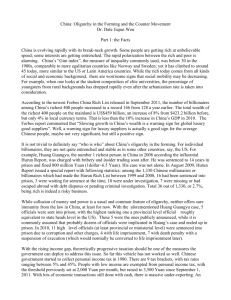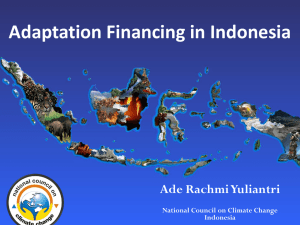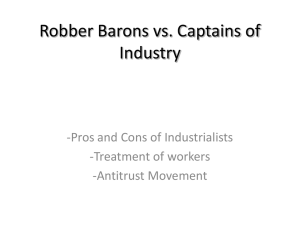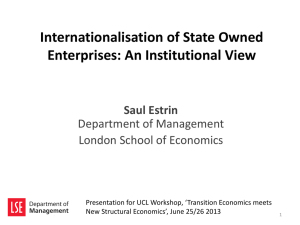State owned enterprises in vietnam
advertisement
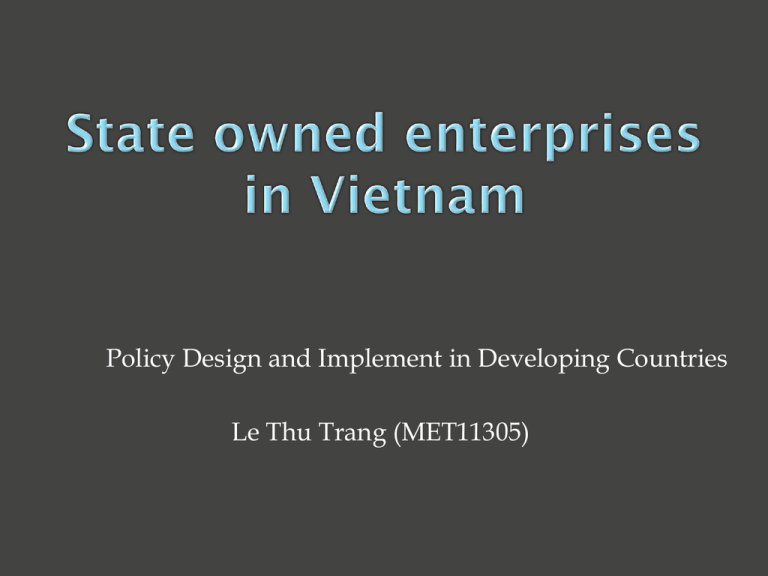
Policy Design and Implement in Developing Countries Le Thu Trang (MET11305) Overview of SOEs in Vietnam Role of Stakeholders Effectiveness of SOEs A case of Vinashin Problems and solutions Show failure of a project due to poor management, lack of regulations and planning. Investments by sector in Vietnam (1995 - 2010) Unit: billion VND 350,000 300,000 250,000 200,000 150,000 100,000 50,000 0 1995 1996 1997 1998 1999 Public Sector 2000 2001 2002 Private Sector 2003 2004 2005 Foreign Sector 2006 2007 2008 2009 2010 Establishment of Groups and State owned Corporations according to decisions of Prime Minister in 1990 and 1991. As a key pillar of Vietnam’s economy to help Vietnam primarily become an industrial country by 2020. As a tool to operate the economy. Necessity: Investment of infrastructure and technology, lack of quality staff and managers and avoid competition from multinational corporations. In 2011: 11 Groups and 85 State owned Corporations. There are two different types of State owned Corporations in Vietnam: STATE OWNED CORPORATIONS 90 Established in 1990 Decisions by Ministries, Local Committees Directors and Staff appointed by Ministers, Head of Local Committees Minimum capital: 500 billion VND (25million USD) Business: Multiple areas In 2006: Government started to privatize and equitize. STATE OWNED CORPORATIONS 91 (GROUPS) Establish in 1991 Decisions by the Prime Minister Management Board: 7 members appointed by the Prime Minister. Minimum capital: 1,000 billion VND (50 million USD) Business: Multiple areas In 2006, they became industrial groups with additional capital from government. Electricity Cement Construction Power Petrol Telecommunication Ship Building Coal and Mineral …. Cover most of business areas in the economy Unit: billion VND Banking Stock Market Insurance Investment Fund Stakeholders Roles Prime Minister - Appoint members of Board. - Approve investment projects of Groups and State owned Corporations. Related Ministries - Provide development strategies for SOEs. - Approve and comment the investment projects of Groups. Ministry of Planning and Investment - Provide development strategies for SOEs. - Approve and comment the investment projects of Groups. Ministry of Labor - Ministry of Finance - Approve and provide capital for SOEs - Financial supervisory function Decide and manage salary and benefit for SOEs’ staff Capital from government budget. Loans with low interest rate (not officially announced). Lower corporation tax rate. Priority in participating government projects compared to private companies. Easy access to state funds and real estate. Lower price of electricity and water. There is lack of regulations or legal framework for SOEs: All Groups are in the trial procedure (trial and correction style). In 2004, 8 Groups were established. 4 others were established in 2009. There are only 4 articles in Law of Corporations 2005 about features, functions and responsibilities of SOEs. Detailed legal regulation is decided by Government. However, only in 2011, Decree No 101 on trial establishment of Groups were issued. Total assets Total Debts Capital Revenue Profit before tax In 2011, there were 11 groups and 85 state corporations. Contributed 34% of GDP (2010). Most of SOEs had profits, however, some groups had big loss: EVN – 24,000 billion VND (1.2 billion USD), Vinashin – 5,000 billion VND (250 million USD),… Rate of profit before tax on capital is 13,1% (compared to lending interest rate 15-20%) 80% profit from 4 Groups: Petro Vietnam, VNPT, Viettel, Vietnam Rubber Group. 30/85 state corporation had rate of debts on total assets greater than 3. 7/85 state corporation had rate of debts on total assets greater than 10. Total debt of SOEs is 50.4 Billion USD compared to 39.5 billion USD of own capital. High potential risk Established in 2006 according to Decision signed by Prime Minister Goal: to implement development strategy to develop ship building industry. To become world number 4 shipbuilder by 2015. Business areas: ship building, shipping and cargo services, import and export, other business areas. 60,000 employees and 28 shipyards 1st Sep 2005: Prime Minister approved to provide a 750 million USD loan to Vinashin with 6.975% annual interest rate (compared to the annual lending interest rate from 15% to 20% for private sector). 2007, State Bank of Vietnam lended Vinashin 600 million USD. Many other loans with 0% interest rate. Provided large plots of land for Vinashin expansion. However, Loss: 5,000 billion VND (due to high speed passenger boat and 2 electricity plants without approval). 160 contracts were cancelled due to global crisis. Big amount of debts: 4.4 billion USD and 600 million USD from foreign financial institutions (compared to 4.7 billion USD of total assets). Went bankrupt. Transfer business activities and debts to other Groups. Established more than 200 companies under management of Vinashin in many business areas. Approved many projects without approval from Government. Appointed many relatives to be managers and take individual benefits. Provided erroneous reports to Government. Intentionally violated state regulations on economic management. Hide many transactions from Government. Scale of trial project (establishment of State Corporations and Groups) is too large (capital, business areas). Regulations are cursory responsibilities and obligations of each stakeholder are not clear. Lack of distinguish between ownership and management of the Government. Easy access to funding encourages both negligence and poor corporate governance among SOEs. Poor capability of staff. Reform structure of the whole economy (Project of Ministry of Planning and Investment). Detailed regulations about responsibilities and obligations of each stakeholder. Privatize SOEs (since 2006 for state owned corporations) and require Groups to divest their non-core business activities. Independent supervisor agency. Improve transparency of investment, financial performance and management. Improve equality between public sector and private sector. THANK YOU!

